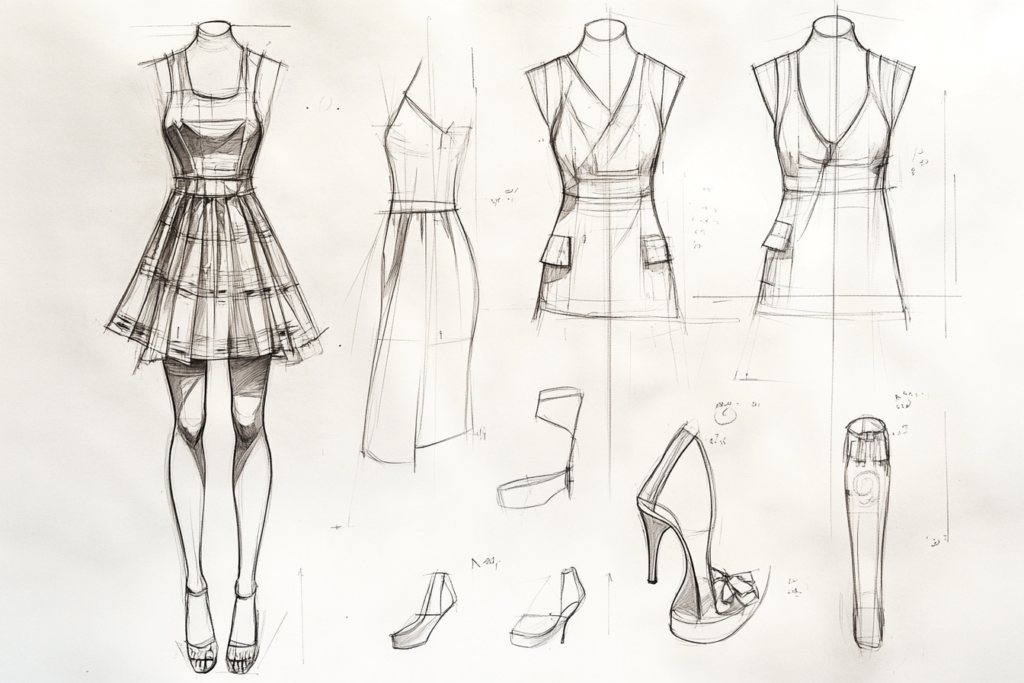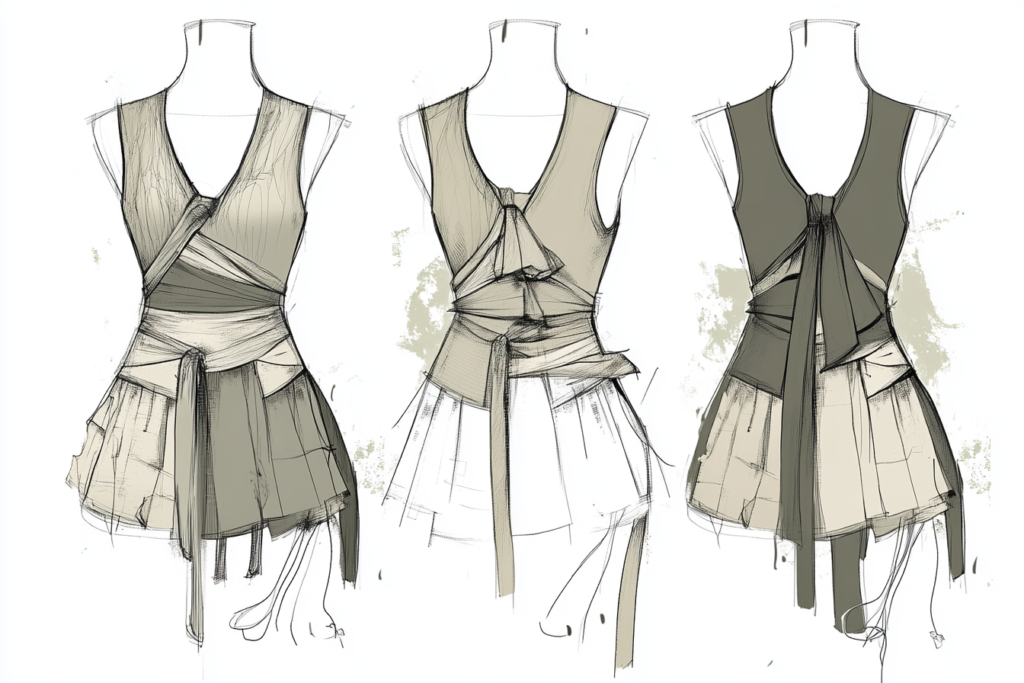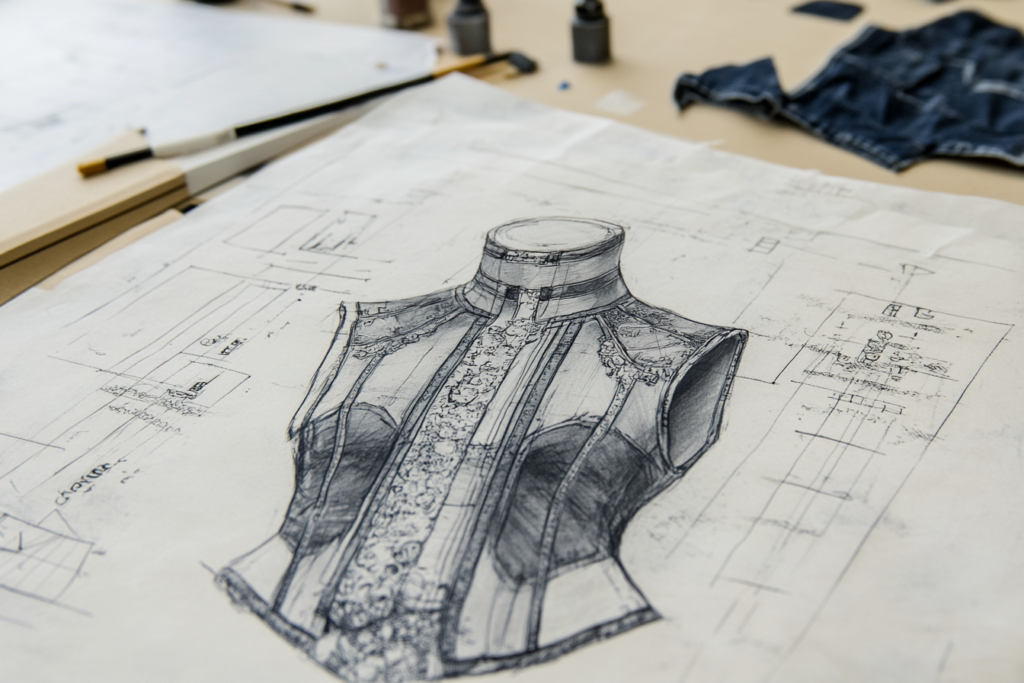Introduction: What is Design Ease?
Design ease refers to the deliberate adjustment of a garment’s fit to achieve the desired silhouette. It involves controlling how tight or loose the garment is at various points, based on the design concept and the body shape it’s meant to fit. Design ease allows designers to create a garment that not only looks good but also provides comfort and movement for the wearer.
In fashion design, ease is crucial for ensuring that a garment suits the body shape and enhances the overall silhouette. This may mean making certain parts of the garment more relaxed, such as at the bust or hips, or creating a tighter fit in areas like the waist. The right amount of design ease ensures that the garment fits as intended, is wearable, and allows freedom of movement.


How Design Ease Works in Garment Construction
- Understanding the Body’s Shape:
- The first step in applying design ease is understanding the body’s natural lines and curves. For example, the waist, bust, and hips may need more ease to create a comfortable fit, while areas like the sleeves or legs may require more structure or a tighter fit. By analyzing these areas, a designer can strategically add or reduce ease to flatter the figure.
- Adjusting the Fit Based on Design Requirements:
- Depending on the garment’s style, the amount of ease will differ. For a form-fitting dress, less design ease is added to create a more tailored look, while for a loose, flowing blouse, more ease may be incorporated to allow the fabric to drape elegantly. The key is to balance the fit with the intended look of the garment.
- Design Ease vs. Functional Ease:
- While design ease is about the aesthetic fit of the garment, functional ease refers to the ease needed for comfort and movement. For instance, a jacket might have both design ease for a tailored appearance and functional ease in the sleeves and shoulders for ease of motion.
- Incorporating Ease into Pattern Making:
- Designers typically add ease into their patterns by adjusting the measurements for specific areas of the garment. This could involve altering the bust, waist, and hip measurements for a relaxed fit or tapering the waist for a more structured look. These adjustments allow the garment to flow with the wearer’s movements while maintaining a flattering shape.
Types of Design Ease
- Negative Ease:
- Negative ease occurs when the garment is designed to fit snugly around the body, usually in stretch fabrics that mold to the wearer’s shape. Garments like body-con dresses or leggings are examples of clothing designed with negative ease, where the fabric has no excess and fits tightly to the contours of the body.
- Positive Ease:
- Positive ease refers to the additional space left in a garment to create a looser fit. This type of ease is often used in garments like tunics, blouses, or pants, where comfort and breathability are important. Positive ease allows the fabric to flow and drape naturally, without feeling restrictive.
- Balanced Ease:
- A balanced amount of ease is applied when designers want the garment to have a neither too tight nor too loose fit. This is the most common form of ease used in everyday clothing like shirts, dresses, and jackets, where comfort, fit, and style must all come together.
Why Design Ease Matters
- Flattering the Body Shape:
- The right amount of design ease can help accentuate the wearer’s best features and provide a smooth, flattering look. Whether the garment is meant to hug the body or drape loosely, proper ease ensures that the clothing complements the body’s natural form, creating a stylish silhouette.
- Ensuring Comfort:
- Design ease ensures that the garment is not too tight or restrictive, allowing for movement and comfort. This is especially important for everyday wear or garments meant for active movement, like sportswear or workwear. Adequate ease also helps prevent the garment from feeling too loose or baggy.
- Creating Movement:
- For many garments, particularly dresses, skirts, and blouses, adding the right amount of ease can help the fabric move naturally with the body. This fluidity and drape add to the garment’s overall aesthetic and give it a graceful, relaxed appearance.
- Improving Durability:
- Design ease can also improve the durability of a garment. For instance, giving a jacket or coat a bit of ease around the shoulders or elbows ensures that the fabric doesn’t stress out with wear and tear. This is particularly true for outerwear and garments that need to withstand movement and environmental conditions.
How to Determine the Right Amount of Design Ease
- Consider the Fabric:
- The type of fabric used will affect the amount of ease needed. Stretch fabrics like jersey may require less design ease since they naturally conform to the body, while stiffer fabrics like denim or canvas may need more ease to allow for comfort and movement.
- Style and Silhouette:
- The desired style or silhouette will heavily influence the amount of ease added. For a tailored, structured look, minimal ease is typically used, while for looser, more casual styles, additional ease may be added. For instance, a boxy, oversized shirt will have more ease compared to a fitted blouse.
- Fit Preferences:
- Fit is subjective, and different customers may have different preferences for how loose or tight they want their garments. It’s important to consider target demographics and adjust the ease accordingly to appeal to their fit preferences.
- Pattern Drafting:
- When creating patterns, designers must decide where to add or reduce ease. Patterns can be adjusted to create more ease in certain areas, such as the bust, waist, or hips, or reduced in areas like the arms or legs for a more tailored look.
Common Garments that Use Design Ease
- Dresses:
- Dresses, especially those with fitted bodices, often use design ease to create a flattering shape. A sheath dress may use less ease to maintain a close-fitting silhouette, while a wrap dress may incorporate more ease for a looser fit.
- Blouses and Shirts:
- Design ease is essential in blouses and shirts, where comfort and fit are key. For a more relaxed look, additional ease is added in the bust or waist, while a fitted shirt may use minimal ease to maintain structure.
- Pants and Skirts:
- Pants and skirts often incorporate ease at the waist and hips to allow for comfortable movement. A pencil skirt will have less ease, while a pleated skirt will have more ease to allow for fullness and movement.
- Outerwear:
- Jackets, coats, and other outerwear pieces often use design ease in the shoulders, chest, and hips to allow for layering and ensure that the garment doesn’t restrict movement.
Conclusion: The Importance of Design Ease in Garment Fit
Design ease plays a crucial role in achieving the desired fit and silhouette for a garment. By carefully adjusting the tightness or looseness of various areas, designers can create a more flattering and comfortable garment that moves with the body. Whether for casual wear, formal attire, or activewear, design ease ensures that the garment not only looks great but feels great to wear.



